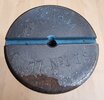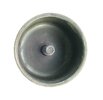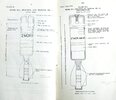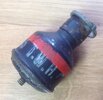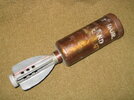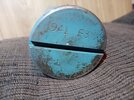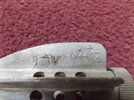British Ordnance Collectors Network
You are using an out of date browser. It may not display this or other websites correctly.
You should upgrade or use an alternative browser.
You should upgrade or use an alternative browser.
2 "mortar, drill or practice
- Thread starter pzgr40
- Start date
Sounds practice sand (as far as I'm aware Belgium used also this one)
pzgr40
Well-Known Member
I just cut the mortar, but what stands out is the fact that a wooden plug is placed in the tail, making the space too short for the normal propulsion cartridge. Is there maybe a shorter propulsion cartridge available for short range practice firing?
And what's the threaded hole in the nose for. No machining (drilling, cutting thread) is done for no reason, as this costs time and money.
And what's the threaded hole in the nose for. No machining (drilling, cutting thread) is done for no reason, as this costs time and money.
Attachments
The wooden plug is possibly to prevent some clown inserting a live cartridge, this would suggest Drill as opposed to Practice. In British service, we didn't have short propelling carts.
The threaded hole in the cap is probably for fitting a ring or similar, to represent a becket. So, if loaded into a "Bomb Thrower" (smoke discharger) on an AFV, it can be easily removed when necessary.
The body is of Canadian manufacture. - https://www.bocn.co.uk/threads/2-mortar-markings.4493/post-264458
TimG
The threaded hole in the cap is probably for fitting a ring or similar, to represent a becket. So, if loaded into a "Bomb Thrower" (smoke discharger) on an AFV, it can be easily removed when necessary.
The body is of Canadian manufacture. - https://www.bocn.co.uk/threads/2-mortar-markings.4493/post-264458
TimG
I like 2" Mortars and found this thread interesting.
Does anyone have a pamphlet showing any 2" Drill mortars as none appear in my No 15A 1945 pamphlet.
My guess is also a Drill mortar but I show Mk 1 and Mk 1/1 Practice 2" mortars and the pamphlet pages.
The 5/16" Whitworth threaded hole in the plug is for the bolt inside the screw-on cap which is removed before firing.
Mk 1 is fixed with one pin to the body and Mk 1/1 is welded to the body.
My Mk 1 has a die-cast plug stamped AMCO 2/44 and is missing the cap.
The Mk 1/1 has a steel plug welded in 3 places and stamped WAV 8/54.
Your interesting mortar has a slotted top and a short plug so possibly a Canadian Drill with the wood in the tail. Nice item.
Does anyone have a pamphlet showing any 2" Drill mortars as none appear in my No 15A 1945 pamphlet.
My guess is also a Drill mortar but I show Mk 1 and Mk 1/1 Practice 2" mortars and the pamphlet pages.
The 5/16" Whitworth threaded hole in the plug is for the bolt inside the screw-on cap which is removed before firing.
Mk 1 is fixed with one pin to the body and Mk 1/1 is welded to the body.
My Mk 1 has a die-cast plug stamped AMCO 2/44 and is missing the cap.
The Mk 1/1 has a steel plug welded in 3 places and stamped WAV 8/54.
Your interesting mortar has a slotted top and a short plug so possibly a Canadian Drill with the wood in the tail. Nice item.
Attachments
My DWS Notes printed in September 1943 has no information about Drill 2 Inch mortar bombs.
If its a drill round then no cartridge should be fitted as its not meant to be fired. Its for class room demonstration. The instructor would place the bomb in the mortar to show how its done correctly and then demonstrate how the bomb is removed if its a misfire. Someone placing a live cartridge in a drill round by mistake would be highly dangerous hence the wooded plug. Sand filled to give the approx weight of a live HE round or Smoke. These sand filled blue drill rounds were fitted with a No5 tail with a extra set of hole. I think the No 5 tail was intended for the signal success round.
I have had a lot of these rounds. They are all WW2 dated, Some are made of British and Canadian parts but most have the fins replaced for later no 5s. I also have one round with original Canadian No2 fins. They are sand filled practice that have been repainted in later practice blue with new fins.
The plug with the threaded hole fits the attachment shown for simulating an explosion, but British made plugs are NOT threaded. The adaptor is Canadian made and not used in British service or the bomb as far as I am aware, they are not shown in any British handbook or in Tony Ds ammo archive. I imagine they used a reduced charge cartridge in later use, hence the inserted wood.
My round with No2 fins is Belgian and came from Ben J via a friend. The other more common type used to be everywhere and are Belgian too as far as im aware, but extra info welcome.
I once found reference to Atelor as a Canadian company but I cant now? Tim G might know.
So In my opinion they are WW2 Canadian, assembled from British and Canadian parts, later re finned and sold to Belgium. They are not drill. Drill are Dark blue with white letters post war. If any Belgian members can add info or confirm Belgian use I would be grateful. ( Adaptor pic Gary K and original bomb via bocn)
The plug with the threaded hole fits the attachment shown for simulating an explosion, but British made plugs are NOT threaded. The adaptor is Canadian made and not used in British service or the bomb as far as I am aware, they are not shown in any British handbook or in Tony Ds ammo archive. I imagine they used a reduced charge cartridge in later use, hence the inserted wood.
My round with No2 fins is Belgian and came from Ben J via a friend. The other more common type used to be everywhere and are Belgian too as far as im aware, but extra info welcome.
I once found reference to Atelor as a Canadian company but I cant now? Tim G might know.
So In my opinion they are WW2 Canadian, assembled from British and Canadian parts, later re finned and sold to Belgium. They are not drill. Drill are Dark blue with white letters post war. If any Belgian members can add info or confirm Belgian use I would be grateful. ( Adaptor pic Gary K and original bomb via bocn)


